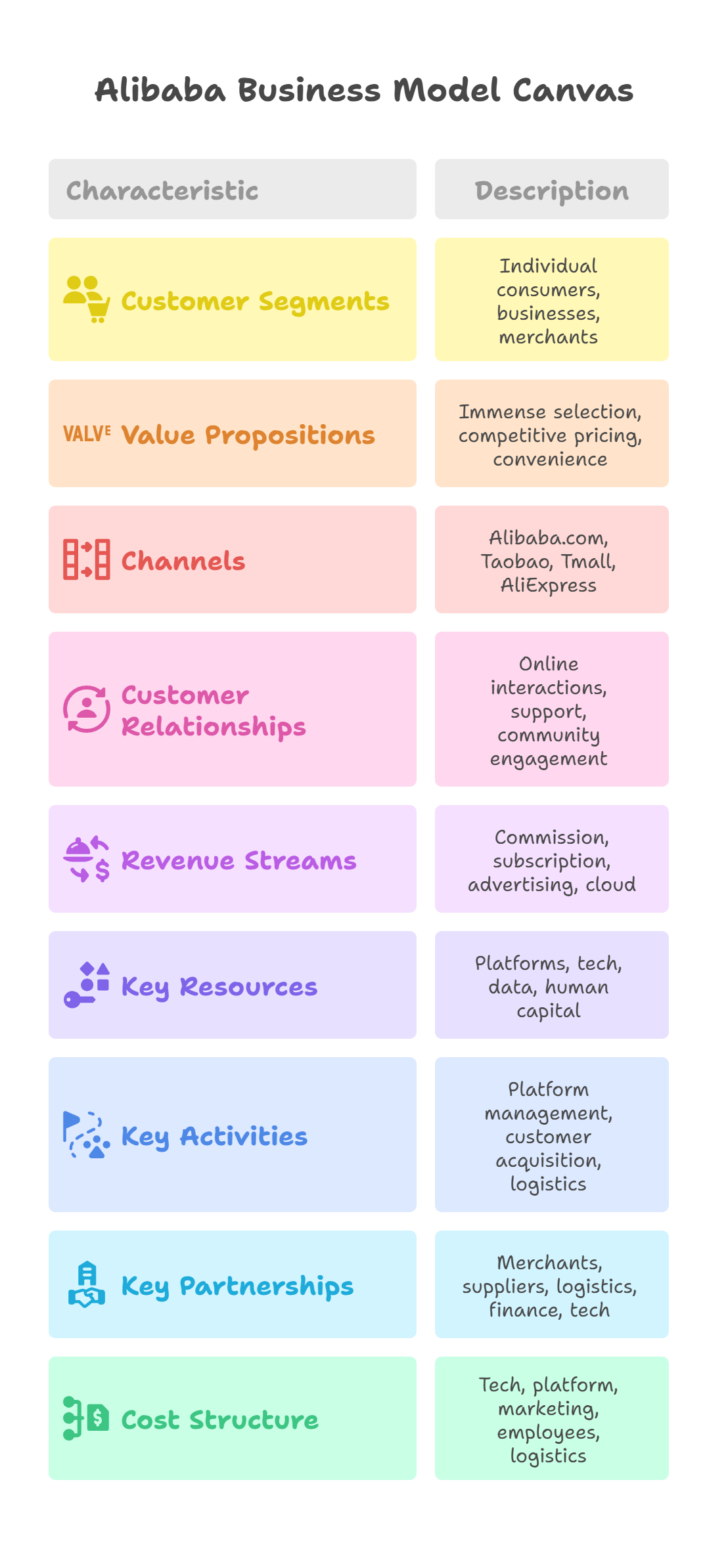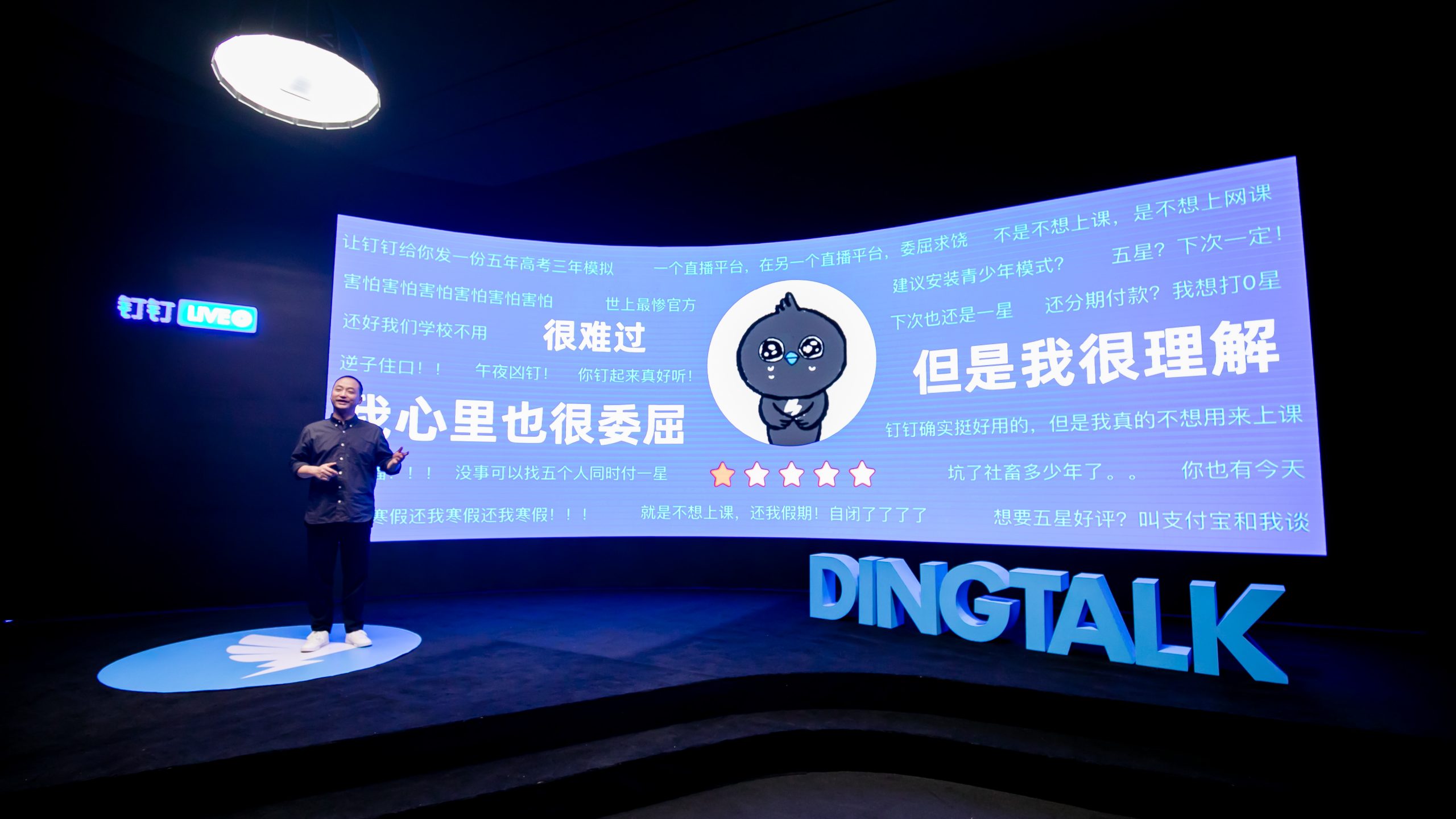Alibaba Business Model Canvas Analysis: How Alibaba Makes Money and Its Ecosystem Strategy

The Alibaba business model is a prime example of how digital ecosystems can generate massive value across multiple industries. More than just an e-commerce platform, Alibaba integrates commerce, logistics, cloud, and fintech into a cohesive strategy that drives both revenue and market dominance. This Business Model Canvas analysis unpacks how Alibaba makes money, what powers its core platforms, and how its ecosystem approach sets it apart. Dive in to explore the mechanics behind one of the world’s most influential business models!
>> See more:
- Temu business model analysis: How does Temu make money?
- 20 Popular Wholesale Vendors for Small Businesses in 2025
I. What is Alibaba Group?
Overview and Founding
Alibaba Group Holding Limited, commonly known as Alibaba, is a leading Chinese multinational specializing in e-commerce, retail, internet services, and technology. It was founded on June 28, 1999, in Hangzhou by Jack Ma and 17 friends and students. Starting from Jack Ma’s apartment, Alibaba.com launched as a B2B marketplace to support Chinese SMEs in exporting goods and navigating global trade challenges.
The company became profitable by 2002. In October 1999, it raised US$25 million from major investors like Goldman Sachs, SoftBank, and Investor AB, showing strong early support. The name “Alibaba” was chosen for its global appeal and easy pronunciation, representing a gateway to success for small businesses worldwide.

Mission and Vision
Alibaba’s mission is simple: “to make it easy to do business anywhere.” It reflects the founders’ belief that the Internet can empower small businesses to grow and compete globally. But Alibaba’s vision goes far beyond e-commerce; it aims to build the future infrastructure of commerce, creating a world where people can “meet, work, and live at Alibaba.” With a bold goal to last 102 years and span three centuries, the company takes a long-term view, focusing on solving customer problems rather than chasing short-term profits.

Evolution and Scope
After its early success in B2B commerce, Alibaba began expanding rapidly from 2003, launching new platforms like Taobao (C2C), Tmall (B2C), Alipay (online payments), and Alimama (digital marketing). This expansion strengthened its position in the global e-commerce space, especially in its fierce competition with eBay in China. By focusing on local trust, leveraging tech, and growing market share even at a loss, Alibaba eventually outperformed eBay, which later exited the Chinese market.
Over time, Alibaba grew into a vast business ecosystem, offering everything from cloud computing (Alibaba Cloud) and logistics (Cainiao) to entertainment (Youku) and work tools (DingTalk). Its many platforms include AliExpress, Lazada, Fliggy, and Freshippo, serving both businesses and consumers across industries.
A major shift came in March 2023 with the launch of the “1+6+N” restructuring plan, splitting Alibaba into six independently operated businesses, each with its own CEO and board. This move aims to boost agility, support independent growth and fundraising, and respond to regulatory changes more effectively, especially after increased scrutiny in 2020.
Throughout all its growth, Alibaba has stayed true to its core mission: making it easy to do business anywhere. Every expansion, from Alipay and logistics to cloud services, has been a strategic step toward removing friction for merchants and customers alike. Rather than chasing trends, Alibaba has consistently built services that support a long-term vision. By creating a deeply interconnected ecosystem, it offers a more complete solution than standalone marketplaces like eBay, making it a powerful and enduring force in global commerce.
>> You may also like: Lazada Business Model Canvas & Mobile Strategy Snapshot (with Infographic)

II. Alibaba Business Model Canvas: A Comprehensive Breakdown
The Business Model Canvas serves as a strategic management tool for conceptualizing, developing, and documenting business models. Alibaba business model canvas provides a clear articulation of its key entities, foundational elements, customer relationships, target segments, essential resources, cost structure, and diverse revenue streams.
Customer Segments
Alibaba’s customer segments are notably diverse, encompassing individual consumers, various businesses, and a wide array of merchants. The primary customer groups include individual consumers seeking an extensive selection of products and services, as well as businesses aiming to broaden their market reach through online retail channels. This broad segmentation reflects Alibaba’s ambition to serve a wide spectrum of participants within the global commerce landscape.
Value Propositions
Alibaba offers a compelling suite of value propositions to its customers. These include an immense selection of products, competitive pricing, unparalleled convenience, and broad accessibility. For individual consumers, the platforms provide access to millions of products sourced from around the world. For businesses, Alibaba’s platforms offer enhanced visibility, extensive marketing opportunities, and direct access to a global customer base, thereby facilitating international trade and growth.
Channels
The company operates a multitude of online platforms and marketplaces that serve as the primary channels for connecting buyers and sellers. Key among these are Alibaba.com, Taobao, Tmall, and AliExpress. These digital channels are instrumental in facilitating e-commerce transactions, enabling seamless communication between buyers and sellers, and promoting a vast array of products and services to a global audience.
>> Explore: 8 Best Cheap Shopping Apps Like AliExpress in 2025
Customer Relationships
Alibaba cultivates customer relationships through a combination of online interactions, dedicated customer support services, and active community engagement. The company places a high priority on customer satisfaction, striving to deliver a seamless and personalized shopping experience for its users. To foster trust and loyalty within its user base, Alibaba actively encourages feedback, product reviews, and direct interactions between buyers and sellers on its platforms.
Revenue Streams
Alibaba generates revenue through a diversified portfolio of streams, including commission fees, subscription fees, advertising income, and cloud computing services. A significant portion of its revenue is derived from commission fees charged to merchants for transactions conducted across its various platforms. Additionally, Alibaba provides subscription-based services to businesses and offers extensive advertising opportunities for sellers seeking to enhance their product visibility. Cloud computing services, provided through its subsidiary Alibaba Cloud, have also emerged as a substantial contributor to the company’s overall revenue.
Key Resources
The foundational key resources underpinning Alibaba’s operations include its extensive online platforms, robust technology infrastructure, sophisticated data analytics capabilities, and a substantial human capital base. The company strategically invests heavily in technology development, advanced data analytics, and talent acquisition to maintain its competitive edge and drive continuous innovation within the e-commerce industry.
Key Activities
Alibaba’s core activities are centered around comprehensive platform management, continuous customer acquisition, efficient product sourcing, intricate logistics coordination, and dynamic marketing efforts. The company is committed to the ongoing optimization of its platforms, the consistent acquisition of new customers, the strategic expansion of its product offerings, the enhancement of its logistics network, and the execution of impactful marketing campaigns to sustain growth and profitability.
Key Partnerships
Alibaba engages in extensive collaborations with a diverse range of partners, including merchants, suppliers, logistics providers, financial institutions, and technology companies. These strategic partnerships are integral to supporting its vast operations and expanding its multifaceted ecosystem. They enable Alibaba to leverage external expertise, resources, and capabilities, thereby enhancing its service offerings and creating augmented value for its diverse customer base.
Cost Structure
Alibaba’s cost structure includes spending on technology infrastructure, platform maintenance, marketing, employee compensation, customer support, logistics, payment processing, and regulatory compliance. The company follows a cost-driven model, aiming to reduce expenses through automation and operational efficiency, which supports scalable and sustainable growth.
A key element of Alibaba’s model is its role as a multi-sided platform that connects buyers and sellers, rather than acting as a traditional retailer. Unlike Amazon, Alibaba does not hold inventory. This asset-light strategy lowers operational costs and enables the company to focus resources on platform development, technology investment, and ecosystem expansion.
Strategic investments in technology—such as cloud infrastructure, data analytics, and skilled talent—are closely tied to Alibaba’s core operations, including customer acquisition, logistics, and marketing. These investments enhance user experience and increase the platform’s value for both merchants and consumers.
This approach reflects long-term thinking. Alibaba treats technology investment not as a cost burden, but as a way to drive future efficiency. By automating operations and optimizing processes, the company lowers per-transaction costs, offers competitive pricing, and improves overall performance. This positions Alibaba for continued growth and lasting competitive advantage.

III. Alibaba’s Diverse Revenue Streams: A Deep Dive into How Alibaba Makes Money
Alibaba Group’s financial performance demonstrates a robust and diversified revenue model, enabling it to generate income from multiple streams across its extensive ecosystem. For the twelve months ending March 31, 2025, Alibaba Group reported a revenue of $137.300 billion, marking a 5.33% increase year-over-year. This growth follows a 3.05% increase in annual revenue from fiscal year 2023 to fiscal year 2024, reaching $130.35 billion.
Overall Revenue Breakdown
The Taobao and Tmall Group, which constitutes Alibaba’s China Commerce Retail segment, remains the highest performing revenue source, contributing $58.95 billion in the last fiscal year. Alibaba organizes its earnings reporting across seven distinct segments: Taobao and Tmall Group, Cloud Intelligence Group, International Digital Commerce Group, Cainiao, Local Consumer Services, Digital Media and Entertainment, and Innovation Initiatives and Other. This segmentation provides a clear view of the company’s multifaceted monetization strategy.
Table: Alibaba Revenue by Segment (Fiscal Year Ended March 31, 2025)
| Segment | Revenue (Billion RMB) |
| Taobao and Tmall Group | 449.83 |
| Innovation Initiatives and Other | 206.72 |
| International Commerce | 132.30 |
| Cloud | 118.03 |
| Cainiao | 101.27 |
| Local Consumer Services | 67.08 |
| Digital Media and Entertainment | 22.27 |
Note: Data for March 31, 2025, from. Figures are in Billions of RMB.
China Commerce (Domestic E-commerce Retail: Taobao, Tmall)
The domestic e-commerce retail segment, primarily driven by Taobao (C2C) and Tmall (B2C), forms the bedrock of Alibaba’s revenue generation. Taobao functions as an open-market platform for small businesses and entrepreneurs to directly connect with consumers, while Tmall provides a curated space for both international and Chinese brands to establish virtual storefronts. This segment was a primary source of Alibaba’s e-commerce revenue, contributing 41% of the company’s total revenue in fiscal year 2024.
Revenue models within this segment are diverse, encompassing commission on sales, various membership fees, and charges for value-added services. Advertising also represents a significant revenue stream, facilitated through featured listings, sponsored products, and targeted marketing campaigns, notably powered by platforms like Alimama and the AI-powered marketing solution Quanzhantui. Tmall, specifically, generates income through commissions, service fees (including a one-time fixed security deposit and an annual technology and service fee), and marketing services provided to suppliers. While Taobao generally operates with no transaction fees, sellers can opt to pay for additional features, such as enhanced exposure on the site. Furthermore, the 88VIP premium membership program, which saw double-digit year-over-year growth to reach 49 million members, significantly contributes to monetization within this segment.
A nuanced examination reveals a point of divergence: while Alibaba’s e-commerce platforms primarily generate revenue from commissions and advertising, the explicit inclusion of “sales of goods” as a revenue component, particularly in China commerce retail and international commerce retail, indicates a hybrid business model. This implies that Alibaba is not exclusively a pure intermediary and does engage in direct sales or inventory holding in specific segments. This is evident in its “new retail strategy”, which aims to integrate online and offline commerce, blurring the lines between a pure marketplace and a direct retailer. This strategic evolution allows Alibaba to capture a greater share of the retail value chain by directly participating in the sale of goods, especially within its integrated online-to-offline models.

International Commerce (Global E-commerce: AliExpress, Lazada)
Alibaba’s international commerce segment, driven by platforms such as AliExpress and Lazada, plays a crucial role in its global footprint. AliExpress enables small Chinese businesses to sell directly to international online buyers, while Lazada operates as the largest e-commerce platform across Southeast Asia. In fiscal year 2024, international sales contributed approximately 9% of Alibaba’s total revenue. This segment’s revenue is derived from customer management, commissions, and direct sales of goods.
AliExpress specifically generates revenue through seller fees based on each successful sale, transaction fees for payment processing, advertising fees for seller promotion, and charges for additional services like logistics support and premium seller accounts. Similarly, Lazada operates on a marketplace model, earning commission fees from sellers on successful transactions and revenue from advertising and promotional services. Lazada also diversifies its revenue through logistics solutions and strategic partnerships.

Cloud Computing (Alibaba Cloud)
Alibaba Cloud has emerged as one of the company’s most significant and rapidly growing revenue streams. It provides a comprehensive suite of scalable IT services, including elastic computing, storage solutions, network infrastructure, security services, big data analytics, and artificial intelligence (AI) capabilities. Alibaba Cloud holds the distinction of being the largest high-end cloud computing company in China.
The revenue model for Alibaba Cloud is structured around subscription services, pay-as-you-go computing resources, and tailored enterprise solutions. The platform offers flexible pricing options, including pay-as-you-go, subscription, and various resource packages. Notably, Alibaba Cloud has adopted an aggressive pricing strategy for its large language models (LLMs), implementing reductions of up to 85% in access costs. This strategic move aims to capture a larger share of China’s enterprise AI market. The Cloud Intelligence Group reported a 13% increase in revenue to RMB 31.74 billion, with AI-related products consistently achieving triple-digit growth for six consecutive quarters.
Alibaba Cloud’s aggressive LLM pricing strategy, featuring an unprecedented 85% reduction in access costs, indicates a deliberate move to make AI more accessible in China. By making advanced AI technologies more affordable, especially for small and medium-sized businesses, Alibaba aims to disrupt the market, accelerate AI adoption across various industries, and solidify its position as a foundational AI infrastructure provider. This approach could lead to a significant acquisition of enterprise AI clients, even if it means accepting lower initial margins. This strategic positioning aligns with Alibaba’s CEO Eddie Wu’s characterization of AI as “the electricity of the future”, suggesting a long-term play for future market dominance.

Digital Media and Entertainment (Youku Tudou, Alibaba Pictures)
Alibaba’s Digital Media and Entertainment segment encompasses a range of platforms, including Youku (a streaming platform comparable to Netflix), Xiami (a music streaming service), and Alibaba Pictures (focused on film production and distribution). This segment generates revenue through subscription fees for premium content, advertising revenue derived from free content, ticket sales, and production fees for Alibaba Pictures. To expand its presence in the entertainment industry and attract a larger audience, Alibaba’s digital media division committed a substantial $7.2 billion in content investment over a three-year period, as reported in 2016. This segment recorded a revenue of 21.15 billion yuan in 2024.
Logistics (Cainiao Network)
Cainiao Network serves as Alibaba’s smart logistics affiliate, playing a critical role in facilitating high-speed delivery and providing comprehensive supply chain, transport, and delivery capabilities for Alibaba’s extensive e-commerce operations. Cainiao operates on a collaborative platform model, connecting e-commerce companies with a vast network of logistics partners and leveraging data to enhance efficiency across the entire chain. Its ambitious goals include achieving 24-hour delivery within China and 72-hour delivery across the globe.
The revenue for Cainiao logistics services is derived from both domestic and cross-border fulfillment services. In fiscal year 2025, Cainiao’s revenue reached approximately RMB 101.272 billion. The growing demand for international shipping is a key driver of Cainiao’s revenue. The company strategically invests in global logistics infrastructure and integrates resources to offer cost-effective and reliable international express delivery solutions, exemplified by services like ‘5 USD 10-day delivery’.
Local Consumer Services (Ele.me, Koubei)
Alibaba’s Local Consumer Services division integrates several platforms, including the food delivery service Ele.me, the local commerce platform Koubei, the navigation tool Amap, and the travel service Fliggy. This segment connects users with a wide array of offline lifestyle businesses and provides on-demand delivery services, ranging from meals and groceries to dry cleaning, pharmacy deliveries, and various at-home services.
Revenue generation within this segment primarily stems from platform commissions, delivery fees, and charges for various services offered through Ele.me and Koubei. For instance, Ele.me has publicly announced commission fee reductions for restaurants impacted by the pandemic, indicating that commissions are a standard revenue stream. Similarly, Koubei has also waived commission fees for merchants during specific periods, implying that commissions and advertising fees are typical sources of income. The cross-fertilization between services, such as Amap-enabled Gross Merchandise Value (GMV) growth on Koubei and Fliggy, demonstrates the significant synergistic potential for revenue growth within this integrated division.
Innovation Initiatives and Other Tech Services (AI Products, Fintech, DingTalk)
Alibaba has strategically expanded beyond e-commerce through key investments in emerging technologies, aiming to build a future-proof and diversified business ecosystem.
DingTalk, Alibaba’s intelligent workplace platform, is one of its leading innovation projects. It supports digital transformation and workflow management for enterprises. With the integration of Alibaba’s proprietary large language model, Qwen, DingTalk launched its AI Assistant, enhancing productivity through automation. As of March 2024, DingTalk reported 28 million paying daily active users, with subscription pricing such as DingTalk 365 set at around 339 yuan (approximately US$56 per year).

AI products represent another major focus. Alibaba’s Qwen models have gained global recognition as open-source tools, and AI-related services within Alibaba Cloud have seen triple-digit growth for six consecutive quarters. Revenue is generated through APIs and tools on platforms like Model Studio, which provide developers with access to generative AI capabilities. AI is also powering features in Taobao and Tmall, such as Quanzhantui, which optimizes marketing performance within Alibaba’s commerce ecosystem.
Fintech services are primarily delivered through Ant Group, an Alibaba affiliate and operator of Alipay. While Alipay was spun off in 2010, it remains closely tied to Alibaba’s ecosystem. Ant Group earns through transaction fees and interest on escrow funds, while Alibaba receives an annual SME fee. Leveraging user data, Alibaba facilitates a wide range of financial services, acting both as a provider and distribution channel for third-party offerings like wealth management or insurance.
Across these initiatives, a clear pattern emerges: Alibaba is strategically diversifying beyond e-commerce. This shift reduces reliance on its original business model and positions the company to capture growth in high-potential sectors like AI, cloud computing, and local services. The result is a resilient, interconnected ecosystem where each component strengthens the others.
Supporting infrastructure like Cainiao (logistics) and Alipay (payments), originally developed for internal use, has become independently profitable. For example, logistics revenue from Cainiao and fees from Ant Group show how Alibaba turns operational necessities into scalable revenue streams. This demonstrates a virtuous cycle—solutions built to support core operations are later monetized externally, further reinforcing the ecosystem.
IV. FAQs About Alibaba’s Business Model
What is Alibaba’s core business strategy?
Alibaba follows a long-term, customer-first strategy aimed at building a global digital ecosystem. It focuses on empowering SMEs, investing in AI and cloud, and decentralizing its operations for agility and growth. Its ecosystem model connects commerce, technology, and services to create lasting competitive advantages.
Is Alibaba primarily B2B, B2C, or C2C?
Alibaba operates across all three models. Alibaba.com is B2B, Taobao is C2C, and Tmall and AliExpress are B2C. This diversified structure allows it to serve both domestic and international markets.
How does Alibaba generate profit?
Alibaba earns through platform commissions, advertising, and membership fees. It also generates revenue from cloud computing, logistics (Cainiao), fintech (Alipay/Ant Group), digital media, and local services like Ele.me and Koubei.
What is Alibaba’s overall profit model?
Alibaba uses an asset-light marketplace model supported by monetized services like cloud, payments, and logistics. By integrating services into a single ecosystem, it boosts user retention, enables cross-selling, and reinvests profits into high-growth tech for long-term gains.
How does the Alibaba ecosystem work?
Alibaba connects commerce, logistics, payments, media, and cloud through a unified digital infrastructure. This ecosystem supports daily life and business, from online shopping to entertainment and local services. It aims to make Alibaba an indispensable platform for users.

